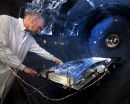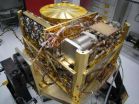(Press-News.org) TEMPE, Az. - An international team of scientists, exploiting pioneering techniques at Arizona State University, has taken a significant step toward unlocking the secrets of oxygenation of the Earth's oceans and atmosphere.
Evolution of the Earth's multitude of organisms is intimately linked to the rise of oxygen in the oceans and atmosphere. The new research indicates that the appearance of large predatory fish as well as vascular plants approximately 400 million years ago coincided with an increase in oxygen, to levels comparable to those we experience today. If so, then animals from before that time appeared and evolved under markedly lower oxygen conditions than previously thought.
The researchers, including collaborators from Harvard, Denmark, Sweden and the United Kingdom, made use of a method developed at ASU by Ariel Anbar, a professor in the department of chemistry and biochemistry and the School of Earth and Space Exploration in the College of Liberal Arts and Sciences, and his research group. The method can be used to estimate global oxygen levels in ancient oceans from the chemical composition of ancient seafloor sediments.
Their important findings are presented in a paper published in this week's online Early Edition of the Proceedings of the National Academy of Sciences (PNAS), titled "Devonian rise in atmospheric oxygen correlated to radiations of terrestrial plants and large predatory fish."
"There has been a lot of speculation over the years about whether or not oxygen in the atmosphere was steady or variable over the last 500 million years," explained Anbar, who leads ASU's Astrobiology Program. "This is the era during which animals and land plants emerged and flourished. So it's a profound question in understanding the history of life. These new findings not only suggest that oxygen levels varied, but also that the variation had direct consequences for the evolution of complex life."
The Earth is 4,500 million years old. Microbial life has probably thrived in the oceans for most of that time. However, until about 2,300 million years ago, the atmosphere contained only traces of oxygen. During that time, some microbes in the oceans likely produced oxygen as a byproduct of photosynthesis. But the quantities they produced were insufficient to accumulate much in the atmosphere and oceans. The situation changed with the "Great Oxidation Event", 2,300 million years ago. Oxygen levels rose again around 550 million years ago. The first animals appear in the fossil record at this time, marking the beginning of an era that geologists call the "Phanerozoic" – a Greek word meaning "evident animals". This new work explores how oxygen levels changed during the Phanerozoic.
The new study was led by Tais W. Dahl while he was a postdoctoral scholar at Harvard. Dahl spent several months in Anbar's lab at ASU during his graduate research learning how to make the necessary measurements from Gwyneth Gordon, Ph.D., who is also an author of this paper. Other authors include geochemist Don Canfield, Dahl's Ph.D. mentor at the University of Southern Denmark, and paleontologist Andrew Knoll, Dahl's postdoctoral mentor at Harvard.
Dahl returned to ASU to perform the measurements for this study, which involved measuring the relative amounts of different isotopes of the element molybdenum in rocks called "black shales". These rocks are formed from ancient ocean sediments.
Isotopes are atoms of an element, in this case molybdenum, that differ only in their mass and therefore can be easily distinguished from one another. Molybdenum has seven stable isotopes. Chemical reactions fractionate heavy from light isotopes. For example, carbon 12 is enriched by three percent in plants relative to the carbon in carbon dioxide in the atmosphere. Similarly, molybdenum isotopes are fractionated during their removal from seawater into ocean sediments. The magnitude of this fractionation is sensitive to the presence of oxygen.
The data Dahl obtained at ASU reveal that there were at least two stages of oxygenation during the Phanerozoic, separated by the oxygenation event 400 million years ago. This inference from molybdenum isotopes is corroborated by the appearance of large (up to 30 feet long) predatory fish in the fossil record 400 million years ago, coincident with the rise in oxygen. Animals of that size consume energy rapidly, requiring high levels of oxygen for their metabolism. "Tais's data indicate that early animals evolved in an environment with less oxygen than today," said Anbar. The newly discovered oxygenation event therefore explains the puzzling appearance of these fish in the fossil record. "It's always satisfying when we can demonstrate how an environmental change drove biological evolution," Anbar explained.
"But the real kicker is that these data also show us the reverse - that biological innovation can drive environmental change" continued Anbar. He points to the fact that vascular plants also appear in the fossil record around 400 million years ago. The bodies of such plants decompose with difficulty, making it easier for organic carbon to be buried in sediments. When that happens, the organic carbon – produced by photosynthesis – is not available for reaction with oxygen. The consequence is a rise in the amount of oxygen in the environment.
"It's a push-me-pull-you situation," explained Anbar. The biological innovation of vascular plants led to more carbon burial, and therefore to more oxygen. Then, the rise in oxygen made it possible for larger animals to evolve. "This is a great example of what we call the "co evolution" of life and the environment", enthused Anbar "Geoscientists talk about this idea a lot, but we rarely find such nice examples."
INFORMATION:
This work was supported by the Danish National Research Foundation, Danish Council for Independent Research, the Swedish Research Council, the NASA Astrobiology Institute team at ASU and the NASA Exobiology Program.
Source:
Ariel Anbar, (480) 965-2747
Media contact:
Written by:
Jenny Green, (480) 965-1430; jenny.green@asu.edu
Plants kick-start evolutionary drama of Earth's oxygenation
2010-10-10
ELSE PRESS RELEASES FROM THIS DATE:
Taking a fresh look
2010-10-10
Educational policy is controversial: positions on achievement gaps, troubled schools and class size are emotionally charged, and research studies often come to very different conclusions.
But what if there was a new way of looking at the problem -- a way that treats education as a complex system (taking into account all interactions) and uses computer modeling and network analysis to provide a comprehensive look at the outcomes of policy choices?
Researchers at Northwestern University's McCormick School of Engineering and Applied Science and School of Education and ...
Texas Tech researcher: Bee colony collapse associated with viral, fungal infection
2010-10-10
The sudden death of bee colonies since late 2006 across North America has stumped scientists. But today, researchers may have a greater understanding of the mysterious colony collapse disorder, said a Texas Tech University biologist.
Shan Bilimoria, a professor and molecular virologist, said the bees may be taking a one-two punch from both an insect virus and a fungus, which may be causing bees to die off by the billions.
Bilimoria is part of a team of researchers searching for the cause of the collapse. Led by research professor Jerry Bromenshenk from the University ...
Improving sonography requires improving sonography school admissions
2010-10-10
COLUMBIA, Mo. – Diagnostic ultrasounds are the most widely used medical tests in the world. Though the technology is more than 50 years old, scientists continue to discover new uses for it, ranging from more targeted cancer treatments to liposuction. As the technology becomes more complex, a sonographer's skill level is even more important. Now, researchers at the University of Missouri may have found one of the keys to becoming a successful sonographer: spatial ability.
Doug Clem, clinical assistant professor of MU's diagnostic ultrasound program in the MU School ...
Webb Telescope sunshield passes launch depressurization tests to verify flight design
2010-10-10
NASA's James Webb Space Telescope continues to make significant progress, successfully completing a series of sunshield vent tests that validate the telescope's sunshield design.
"While adequate venting is a design consideration for all spaceflight hardware, this was a particularly unique challenge for the sunshield given the large volume of trapped air in the membrane system at launch," said Keith Parrish, Webb telescope sunshield manager at NASA's Goddard Space Flight Center in Greenbelt, Md. "From the beginning of its development venting features have been a critical ...
Women's race and class impact contraception recommendations, UCSF study shows
2010-10-10
A woman's race/ethnicity and socioeconomic status impact whether health care providers recommend one of the most highly effective forms of contraception, a UCSF study confirms. The results also indicate that the interaction of both factors plays a role in clinicians' decisions.
Recommendations by health care providers previously have been found to vary by patients' race and socioeconomic status, contributing to health disparities, according to the researchers. The team investigated the effect of these factors on recommendations for contraception.
Study results appear ...
Alienated youths are more likely to lash out
2010-10-10
When people are rejected by peers, they often lash out. In children, that aggression occasionally takes horrifying directions, leading to school shootings or other deadly acts. Researchers in the Netherlands found that some children are more likely than others to lash out in response to acute peer rejection: children who already feel like outcasts.
"It was inspired by the fact that we had these school shootings and wondered what the most important feature of these kids could be," says Albert Reijntjes of Utrecht University, who cowrote the study with five other psychological ...
Researchers discover a new class of highly electronegative chemical species
2010-10-10
RICHMOND, Va. (Oct. 8, 2010) – An international team of researchers has discovered a new class of highly electronegative chemical species called hyperhalogens, which use superhalogens as building blocks around a metal atom. The new chemical species may have application in many industries.
Researchers from Virginia Commonwealth University, McNeese State University in Lake Charles, La., and the University of Konstanz in Germany report their discovery in the Oct. 6 international chemistry journal Angewandte Chemie International Edition. The journal designated the paper as ...
NASA sees Otto become eighth hurricane of the Atlantic season
2010-10-10
At 11 a.m. EDT on Oct. 8, Otto strengthened into a hurricane, becoming the eighth hurricane of the Atlantic Ocean season. NASA's Aqua satellite and the NOAA GOES-13 satellite captured images of Otto as he intensified.
Otto had maximum sustained winds near 75 mph, and the National Hurricane Center in Miami, Fla. noted that some strengthening is possible before it weakens on Saturday, Oct. 9. Otto was located about 445 miles south of Bermuda near 25.9 North and 64.0 West. It was moving east-northeast near 17 mph, and had a minimum central pressure of 979 millibars.
On ...
NASA's Mobile Mars Laboratory almost ready for flight
2010-10-10
The Sample Analysis at Mars (SAM) instrument suite has completed assembly at NASA's Goddard Space Flight Center in Greenbelt, Md., and is nearly ready for a December delivery to NASA's Jet Propulsion Laboratory (JPL), Pasadena, Calif., where it will be joined to the Curiosity rover. SAM and Curiosity are set to fly on the on the upcoming Mars Science Laboratory (MSL) rover mission scheduled for launch in the fall of 2011.
SAM will become an automated, mobile laboratory as it is carried across Mars by the rover when the mission arrives at the Red Planet in 2012. Together ...
UT Southwestern researchers create experimental vaccine against Alzheimer's
2010-10-10
DALLAS – Oct. 12, 2010 – Researchers at UT Southwestern Medical Center have created an experimental vaccine against beta-amyloid, the small protein that forms plaques in the brain and is believed to contribute to the development of Alzheimer's disease.
Compared with similar so-called DNA vaccines that the UT Southwestern researchers tested in an animal study, the new experimental vaccine stimulated more than 10 times as many antibodies that bind to and eliminate beta-amyloid. The results appeared in the journal Vaccine.
Future studies will focus on determining the ...




